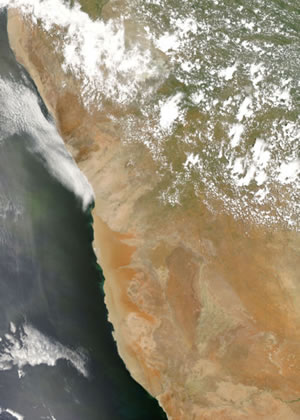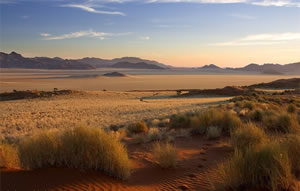The Namib, which believed to be the world's oldest desert, stretches from the Orange River in the south to the Angolan border in the north stretches for 2,080km (1,300mi)
It is never more than 160km (100mi) wide. In some areas, it is as narrow as 10km (6mi) wide.
 The Kuiseb River, which flows into the Atlantic at Walvis Bay, divides the Namib into two.
The Kuiseb River, which flows into the Atlantic at Walvis Bay, divides the Namib into two.
To the south of the Kuiseb is a great sand sea containing large areas of parallel dunes with regular troughs, nicknamed "streets", in between.
Here, in the ancient gravel terraces beneath the sands, lies the world's greatest single deposit of gem diamonds. Before the dunes were formed more than a million years ago, the mixture of jewels and gravel was washed down to the sea by the Orange River from South Africa's Kimberley region. The diamonds were swept north on coastal currents, deposited on the shore of the Namib Desert and later covered by sand from the same river valley.
The climate of the Namib Desert is forged by westerly winds. Flowing north from the waters of the Antarctic is the powerful but cold Benguela Current. Moisture-laden westerlies from the warm Atlantic Ocean are cooled when they meet this current. This causes to release their over the sea. As a result, the Namib receives an average annual rainfall of only 2.5cm (1in).
The sand dunes of the desert receive moisture from the atmosphere, in the form of fog. Every 10 days or so, a dense night fog rolls inland for a distance of 80km (50mi) or more, shrouding the coast and much of the desert. The fog condenses into a thick dew, creating an annual average of 4cm (1.6in) of moisture
Temperature in the Namib reaches a high of 66°C (150°F) in the middle of the day.
Gravel and rock plains extend north from the Kuiseb River. The treacherous coastal waters of this region regularly snare ships, such as the Dunedin Star (1942) and the Shawnee (1976), and cast them up on the shifting sands. The rusty hulls of many wrecks lie stranded on the beach, which sailors have named the Skeleton Coast, the place "where ships and men come ashore to die".
Life in the Namib Desert
 The Namib supports a variety of animals that have adapted to the environment. Most are small, such as beetles, termites, wasps, spiders and lizards, because only those that can live on a small intake of water survive.
The Namib supports a variety of animals that have adapted to the environment. Most are small, such as beetles, termites, wasps, spiders and lizards, because only those that can live on a small intake of water survive.
In the absence of large predators, the animal species have become largely conspicuous, flightless and defenseless.
The animals of the Namib have evolved unique strategies for trapping fog in order to obtain precious moisture.
The ubiquitous button beetles excavate tiny parallel furrows in the sand that are oriented at right angles to the direction of the wind. When the fog rolls in, it condenses on the sand grains of the furrow's ridges; the button beetles then suck them dry.
Headstander beetles wait for the fog to arrive on the windward side of coastal sand dunes. When they sense the approach of the white mists, they climb to the crest of a steep-sided dune and balance upside down with their backs to the wind and their heads between their legs. The fog condenses on their carapaces and trickles down into their waiting mouths.
Lizards rely largely on the insects that are their food for their moisture needs. Clown dune crickets and darkling beetles make succulent feasts. The nocturnal gecko, however, is able to lick the dew from its eyes with its long, flexible tongue.
Predator of the reptile community is the sidewinding sand viper, a distant relative of North America's sidewinder rattlesnake. Like the sidewinder, this snake skims across the hot dunes, leaving parallel tracks at a 45° angle to the direction in which it moves. When hunting, the snake buries its whole body beneath the sand except for its eyes. Curious lizards who venture too close are injected with poison and then eaten.
Among the gravel plains to the north of the Kuiseb River grows the remarkable welwitschia plant. Unique to the Namib, and the only species of its genus, the long-lived welwitschia stands up to 2m (6.6ft) tall with two large leathery leaves that are often torn to ribbons by the desert winds. As the desert fog condenses on its leaves, the plant absorbs the mois¬ture via pores on the leaf surface or, when the condensation drips to the ground, through a network of tiny rootlets.
Many of the Namib's invertebrates feed on detritus, debris borne by the hot east winds. Tiny particles of plant detritus or grains of organic matter collect and become stored in the troughs between the dunes. Beetles graze on these food stores either early in the morning or in the afternoon when the desert sands have cooled from their midday high.